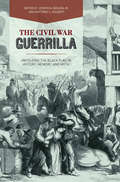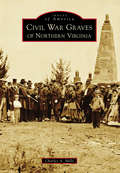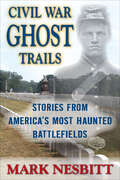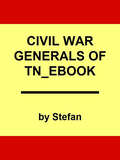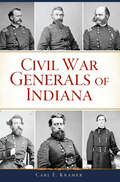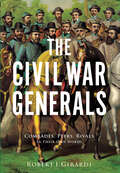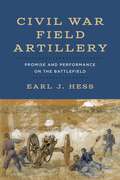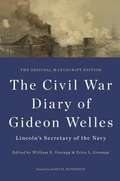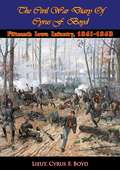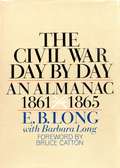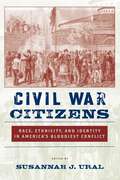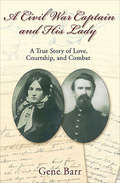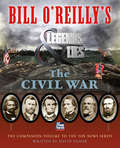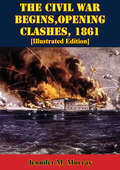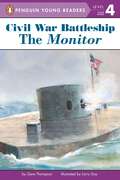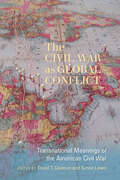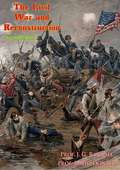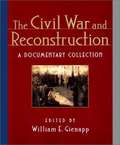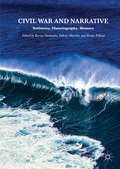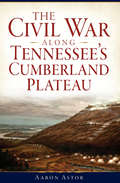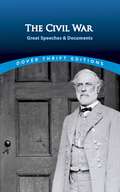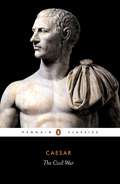- Table View
- List View
The Civil War Guerrilla: Unfolding the Black Flag in History, Memory, and Myth (New Directions in Southern History)
by Matthew C. Hulbert Joseph M. Beilein Jr.Most Americans are familiar with major Civil War battles such as Manassas (Bull Run), Shiloh, and Gettysburg, which have been extensively analyzed by generations of historians. However, not all of the war's engagements were fought in a conventional manner by regular forces. Often referred to as "the wars within the war," guerrilla combat touched states from Virginia to New Mexico. Guerrillas fought for the Union, the Confederacy, their ethnic groups, their tribes, and their families. They were deadly forces that plundered, tortured, and terrorized those in their path, and their impact is not yet fully understood.In this richly diverse volume, Joseph M. Beilein Jr. and Matthew C. Hulbert assemble a team of both rising and eminent scholars to examine guerrilla warfare in the South during the Civil War. Together, they discuss irregular combat as practiced by various communities in multiple contexts, including how it was used by Native Americans, the factors that motivated raiders in the border states, and the women who participated as messengers, informants, collaborators, and combatants. They also explore how the Civil War guerrilla has been mythologized in history, literature, and folklore. The Civil War Guerrilla sheds new light on the ways in which thousands of men, women, and children experienced and remembered the Civil War as a conflict of irregular wills and tactics. Through thorough research and analysis, this timely book provides readers with a comprehensive examination of the guerrilla soldier and his role in the deadliest war in U.S. history.
Civil War Graves of Northern Virginia (Images of America)
by Charles A. MillsMany reminders of the Civil War were left behind in Northern Virginia for future generations to ponder. Also left behind were the graves of those who took part in the tumultuous events of war. Northern Virginia is a treasure house of history, perhaps more so than any other part of the country. One unique way of experiencing that history is by visiting one of the region's many historic cemeteries. Cemeteries have been called open-air museums, and every gravestone has a story to tell. There are some 1,000 cemeteries in Northern Virginia, ranging from small family plots to huge national cemeteries covering hundreds of acres. Many of these cemeteries contain the remains of Civil War veterans. This book is not meant to be an inclusive survey of every cemetery in the region, but rather it is a presentation of the Civil War history of Northern Virginia through the medium of cemeteries.
Civil War Ghost Trails: Stories from America's Most Haunted Battlefields
by Mark NesbittRiveting ghost stories with history from all the major engagements of the war.Civil War Ghost Trails examines the major engagements of the Civil War and their connections to the paranormal world. The history of each battlefield is followed by the classic ghost stories that have been around since the guns fell silent. Mark Nesbitt also collected newer stories and attempted a paranormal investigation, including Electronic Voice Phenomena (EVP), at many of the sites to see what could be found. In some cases, the results were astounding. Some of the spirits included in the book are the Headless Zouave at Bull Run, the Drummer Boy at Shiloh, and the Phantom Battalion at Gettysburg. Ghosts appear at the Bloody Lane at Antietam and Caroline Street in Fredericksburg, as well as sites at Chancellorsville, Vicksburg, Chickamauga, Chattanooga, Petersburg, and Appomattox Court House. A special section of the book explores the haunted Civil War prisons at Johnson&’s Island in Ohio, Point Lookout in Maryland, and Andersonville in Georgia. Abraham Lincoln&’s many White House apparitions are discussed in a section on wartime Washington, D.C.
Civil War Generals of Tennessee
by Randy BishopFrom James Patton Anderson to Felix Zollicoffer, author Randy Bishop, a native Tennessean, offers compelling portraits of the sons of a state regarded by many as the most torn asunder by the War Between the States. This collection brings together biographies of the fifty-one Confederate and Union generals born in Tennessee as well as those with significant ties to the state. Each entry focuses on the major military contributions of the individuals—no matter their affiliations—and also teases out the most intriguing aspects of their civilian life, particularly how they fared after the war. With fascinating details, including the men&’s relationships before the divisiveness of war drove intruded, Bishop provides an insight into lives that have rarely been seen as a whole. Arranged in alphabetical order for ease of reference, the work includes such luminaries as Nathan Bedford Forrest and Leonidas Polk, while also detailing the contributions of many lesser-known figures, including Samuel Powhatan Carter and Otho French Strahl. Each entry spans approximately five pages and provides, as the author states, &“insight into the contributions of selfless men who offered their best, in years of their lives as well as time, that could have been spent with their families.&”
Civil War Generals of Indiana (Civil War Series)
by Carl E. KramerMeet the Hoosier Generals of America's ConflictWhen the Civil War erupted, the Union and the Confederacy faced the challenge of organizing huge armies of volunteers with little or no military experience. Crucial to this task was finding generals, and Indiana answered this call with approximately 120 of them. Though a competent division and corps commander, Ambrose E. Burnside's leadership of the Army of the Potomac at Fredericksburg proved disastrous. Jefferson Columbus was a relentless commander but murdering his superior in a Louisville hotel halted his probable rise to major general. As commander of the Louisville Legion, Lovell H. Rousseau was the only Civil War general commissioned by a city.Compiling years of research, historian Carl E. Kramer provides biographical sketches of every identifiable Indiana general who attained full-rank, brevet, and state-service status in the tragic struggle.
The Civil War Generals: Comrades, Peers, Rivals: In Their Own Words (Civil War America Ser.)
by Robert I. Girardi“An excellent contribution to Civil War literature . . . . [A]n excellent reference resource. Civil War buffs in particular will greatly enjoy this book.” —ArmchairGeneral.comThe Civil War Generals offers an unvarnished and largely unknown window into what military generals wrote and said about each other during the Civil War era. Drawing on more than 170 sources—including the letters, diaries, and memoirs of the general officers of the Union and Confederate armies, as well as their staff officers and other prominent figures—Civil War historian Robert Girardi has compiled a valuable record of who these generals were and how they were perceived by their peers. The quotations within paint revealing pictures of the private subjects at hand and, just as often, the people writing about them—a fascinating look at the many diverse personalities of Civil War leadership. More than just a collection of quotations, The Civil War Generals is also a valuable research tool, moving beyond the best-known figures to provide contemporary character descriptions of more than four hundred Civil War generals. The quotes range in nature from praise to indictment, and differing opinions of each individual give a balanced view, making the book both entertaining and informative. A truly one-of-a-kind compilation illustrated with approximately one hundred historical photographs, The Civil War Generals will find a home not only with the casual reader and history buff, but also with the serious historian and researcher.
Civil War Field Artillery: Promise and Performance on the Battlefield
by Earl J. HessThe American Civil War saw the creation of the largest, most potent artillery force ever deployed in a conflict fought in the Western Hemisphere. It was as sizable and powerful as any raised in prior European wars. Moreover, Union and Confederate artillery included the largest number of rifled pieces fielded in any conflagration in the world up to that point. Earl J. Hess’s Civil War Field Artillery is the first comprehensive general history of the artillery arm that supported infantry and cavalry in the conflict. Based on deep and expansive research, it serves as an exhaustive examination with abundant new interpretations that reenvision the Civil War’s military. Hess explores the major factors that affected artillerists and their work, including the hardware, the organization of artillery power, relationships between artillery officers and other commanders, and the influence of environmental factors on battlefield effectiveness. He also examines the lives of artillerymen, the use of artillery horses, manpower replacement practices, effects of the widespread construction of field fortifications on artillery performance, and the problems of resupplying batteries in the field. In one of his numerous reevalutions, Hess suggests that the early war practice of dispersing guns and assigning them to infantry brigades or divisions did not inhibit the massing of artillery power on the battlefield, and that the concentration system employed during the latter half of the conflict failed to produce a greater concentration of guns. In another break with previous scholarship, he shows that the efficacy of fuzes to explode long-range ordnance proved a problem that neither side was able to resolve during the war. Indeed, cumulative data on the types of projectiles fired in battle show that commanders lessened their use of the new long-range exploding ordnance due to bad fuzes and instead increased their use of solid shot, the oldest artillery projectile in history.
Civil War Dynasty: The Ewing Family of Ohio
by Kenneth J HeinemanFor years the Ewing family of Ohio has been lost in the historical shadow cast by their in-law, General William T. Sherman. In the era of the Civil War, it was the Ewing family who raised Sherman, got him into West Point, and provided him with the financial resources and political connections to succeed in war. The patriarch, Thomas Ewing, counseled presidents and clashed with radical abolitionists and southern secessionists leading to the Civil War. Three Ewing sons became Union generals, served with distinction at Antietam and Vicksburg, marched through Georgia, and fought guerrillas in Missouri. The Ewing family stood at the center of the Northern debate over emancipation, fought for the soul of the Republican Party, and waged total war against the South.In Civil War Dynasty, Kenneth J. Heineman brings to life this drama of political intrigue and military valor—warts and all. This work is a military, political, religious, and family history, told against the backdrop of disunion, war, violence, and grief.
The Civil War Diary of Gideon Welles, Lincoln's Secretary of the Navy: The Original Manuscript Edition
by William E. Gienapp Gideon Welles Erica L. GienappGideon Welles's 1861 appointment as secretary of the navy placed him at the hub of Union planning for the Civil War and in the midst of the powerful personalities vying for influence in Abraham Lincoln's cabinet. Although Welles initially knew little of naval matters, he rebuilt a service depleted by Confederate defections, planned actions that gave the Union badly needed victories in the war's early days, and oversaw a blockade that weakened the South's economy. Perhaps the hardest-working member of the cabinet, Welles still found time to keep a detailed diary that has become one of the key documents for understanding the inner workings of the Lincoln administration. In this new edition, William E. and Erica L. Gienapp have restored Welles's original observations, gleaned from the manuscript diaries at the Library of Congress and freed from his many later revisions, so that the reader can experience what he wrote in the moment. With his vitriolic pen, Welles captures the bitter disputes over strategy and war aims, lacerates colleagues from Secretary of State William H. Seward to General-in-Chief Henry Halleck, and condemns the actions of the self-serving southern elite he sees as responsible for the war. He can just as easily wax eloquent about the Navy's wartime achievements, extoll the virtues of Lincoln, or drop in a tidbit of Washington gossip. Carefully edited and extensively annotated, this edition contains a wealth of supplementary material. The several appendixes include short biographies of the members of Lincoln's cabinet, the retrospective Welles wrote after leaving office covering the period missing from the diary proper, and important letters regarding naval matters and international law.
The Civil War Diary Of Cyrus F. Boyd, Fifteenth Iowa Infantry, 1861-1863 [Illustrated Edition]
by Lieut. Cyrus F. BoydIncludes Civil War Map and Illustrations Pack - 224 battle plans, campaign maps and detailed analyses of actions spanning the entire period of hostilities."[One of] the Union side's most revealing and realistic views of soldier life....The diary is especially important for the light which it throws on such basic matters as the tortuous progression from civilian to veteran, the course of morale, the character of soldier life in a volunteer army, the quality of leadership, the awesomeness of battle, and the brutality of war."--Bell Irvin Wiley, in the Journal of Southern HistoryA native of Warren County, Iowa, Cyrus F. Boyd served a year and a half as an orderly sergeant with the Fifteenth Iowa Infantry before becoming first Lieutenant in Company B of the Thirty-fourth Iowa Infantry. His diary--expanded in 1896 from a pocket diary he carried on his campaigns from Indianola, Iowa, to Lake Providence, Louisiana--offers a full account of soldiering in the Union army. Before his promotion, Boyd was an intermediary between privates and company officers, a position that offered him unique opportunities to observe the attitudes and activities of both the unit leaders and their men. The outspoken Boyd frankly expresses his opinions of his comrades and his commanders, candidly depicts camp life, and intricately details the gory events on the battlefield. Although not always pleasant reading, The Civil War Diary of Cyrus F. Boyd is a vibrant, honest chronicle of one man's experiences in the bloody conflict.The diary has been heavily edited to ensure it can be understood, initially there was little to no punctuation included.
The Civil War Day by Day: 1861-1865
by E. B. Long Barbara LongIn all the vast collection of books on the American Civil War there is no book like this one. It has been needed for a long time, both by the student and by the man who simply likes to read about the Civil War, but until now no one had the dedication or the encyclopedic knowledge to produce it. Here it is, at last—an almanac, or day-by-day recital down to the close conflict, written by Professor E. B. Long of the University of Wyoming. If there was a battlefield in the Civil War that this man has not visited personally, I do not know where it is; if there is an important collection of papers shedding light on the war that he has not examined, it would be hard to name it. It is no exaggeration whatsoever to say that this man knows more facts about the Civil War than any other man who ever lived. To know a subject thoroughly, of course, is one thing; to put the results of that knowledge into lucid prose of manageable compass is something else again. One does not need to examine many pages of this almanac to realize that Professor Long has succeeded admirably in the second task. Crammed into the margins of each page with facts, this book is never soporific. It is for the casual reader as well as for the specialist; it can even, as a matter of fact, be read straight through as a narrative, in which the dramatic and heart-stirring events of America’s greatest time of trial pass before the eye on a day-to-day basis. A book like this has been needed for a long time, but up to now no one was able to write it. It should have a long life, and no one will ever need to do it again. It belongs on the somewhat restricted shelf of Civil War books that will be of permanent value.
Civil War Commando: William Cushing and the Daring Raid to Sink the Ironclad CSS Albemarle
by Jerome PreislerCivil War Ironclads and Commandos Here at last is an action-packed portrait of one of America&’s greatest but little-remembered Civil War heroes, Commander William Barker Cushing, who sank the Confederate ironclad Albemarle in a spectacular mission in 1864. Regarded as erratic and insubordinate, Midshipman Cushing was drummed out of the Naval Academy in March 1861. But with the outbreak of war, the Union needed every trained officer it could find— and whatever his flaws, Cushing was an extremely talented naval officer. Ferocious, uncompromising, courageous, and loyal, he became a U.S. Navy commando and at the age of twenty-one was sent to destroy the South&’s ultimate naval weapon—the Albemarle, an unsinkable vessel with a devastating iron ram. This death-defying mission succeeded in sinking the Albemarle, helped reelect President Abraham Lincoln, and earned Cushing a hero&’s grave in the Naval Academy&’s cemetery. Here is that story, told with all the verve and drama it deserves, shining new light on one of the most important naval encounters of the war. Civil War Commando is a masterpiece of naval history that reads like a thriller and gives a neglected hero his due.
Civil War Citizens: Race, Ethnicity, and Identity in America’s Bloodiest Conflict
by Susannah J. UralAt its core, the Civil War was a conflict over the meaning of citizenship. Most famously, it became a struggle over whether or not to grant rights to a group that stood outside the pale of civil-society: African Americans. But other groups--namely Jews, Germans, the Irish, and Native Americans--also became part of this struggle to exercise rights stripped from them by legislation, court rulings, and the prejudices that defined the age.Grounded in extensive research by experts in their respective fields, Civil War Citizens is the first volume to collectively analyze the wartime experiences of those who lived outside the dominant white, Anglo-Saxon Protestant citizenry of nineteenth-century America. The essays examine the momentous decisions made by these communities in the face of war, their desire for full citizenship, the complex loyalties that shaped their actions, and the inspiring and heartbreaking results of their choices-- choices that still echo through the United States today. Contributors: Stephen D. Engle, William McKee Evans, David T. Gleeson, Andrea Mehrländer, Joseph P. Reidy, Robert N. Rosen, and Susannah J. Ural.
A Civil War Captain and His Lady: A True Story of Love, Courtship, and Combat
by Gene BarrA True Cold Mountain from the Northern PerspectiveMore than 150 years ago, 27-year-old Irish immigrant Josiah Moore met 19-year-old Jennie Lindsay, a member of one of Peoria, Illinoiss most prominent families. The Civil War had just begun, Josiah was the captain of the 17th Illinois Infantry, and his war would be a long and bloody one. Their courtship and romance, which came to light in a rare and unpublished series of letters, forms the basis of Gene Barrs memorable A Civil War Captain and His Lady: A True Story of Love, Courtship, and Combat.The story of Josiah, Jennie, the men of the 17th and their families tracks the toll on our nation during the war and allows us to explore the often difficult recovery after the last gun sounded in 1865.Josiahs and Jennies letters shed significant light on the important role played by a soldiers sweetheart on the home front, and a warriors observations from the war front. Josiahs letters offer a deeply personal glimpse into army life, how he dealt with the loss of many close to him, and the effects of war on a mans physical, spiritual, and moral well-being. Jennies letters show a young woman mature beyond her age, dealing with the difficulties on the home front while her brother and her new love struggle through the travails of war. Her encouragement to keep his faith in God strong and remain morally upright gave Josiah the strength to lead his men through the horrors of the Civil War. Politics also thread their way through the letters and include the evolution of Jennies fathers view of the conflict. A leader in the Peoria community and former member of the Illinois state house, he engages in his own political wars when he shifts his affiliation from the Whig Party to the new Republican Party, and is finally elected to the Illinois Senate as a Peace Democrat and becomes one of the states more notorious Copperheads.In addition to this deeply moving and often riveting correspondence, Barr includes additional previously unpublished material on the 17th Illinois and the wars Western Theater, including Fort Donelson, Shiloh, Vicksburg, and the lesser known Meridian Campaignactions that have historically received much less attention than similar battles in the Eastern Theater. The result is a rich, complete, and satisfying story of love, danger, politics, and warfare, and it is one you wont soon forget.
The Civil War (Bill O'reilly's Legends And Lies Ser.)
by David Fisher<p>The newest installment in the New York Times #1 bestselling companion series to the Fox historical docudrama, Bill O’Reilly’s Legends and Lies; The Civil War is a pulse-quickening account of the deadliest war in American history. <p>From the birth of the Republican Party to the Confederacy’s first convention, the Underground Railroad to the Emancipation Proclamation, the Battle of Gettysburg to the assassination of Abraham Lincoln, Bill O’Reilly’s Legends and Lies: The Civil War reveals the amazing and often little known stories behind the battle lines of America’s bloodiest war and debunks the myths that surround its greatest figures, including Harriet Tubman, Abraham Lincoln, General Robert E. Lee, Frederick Douglass, Stonewall Jackson, John Singleton Mosby, Ulysses S. Grant, Jefferson Davis, John Wilkes Booth, William Tecumseh Sherman, and more. <p>An epic struggle between the past and future, the Civil War sought to fulfill the promise that “all men are created equal.” It freed an enslaved race, decimated a generation of young men, ushered in a new era of brutality in war, and created modern America. <p> Featuring archival images, eyewitness accounts, and beautiful artwork that further brings the history to life, The Civil War is the action-packed and ultimate follow-up to the #1 bestsellers The Patriots and The Real West. <P><b>A New York Times Bestseller</b>
The Civil War Begins, Opening Clashes, 1861 [Illustrated Edition] (The U.S. Army Campaigns of the Civil War #1)
by Jennifer M. MurrayIncludes 6 maps and numerous other illustrationsThe Civil War Begins: Opening Clashes, 1861 is the first in a series of campaign brochures commemorating our national sacrifices during the American Civil War. Author Jennifer Murray examines the successes and challenges of both the Union and the Confederate forces during the early days of the Civil War. Notable battles discussed include: Fort Sumter, South Carolina; Bull Run, Virginia; Wilson's Creek, Missouri; Cape Hatteras, North Carolina; and Port Royal, South Carolina.
Civil War Battleship: The Monitor (Penguin Young Readers, Level 4)
by Gare ThompsonThe U.S.S. Monitor was an entirely new type of warship when it launched in 1862. Dubbed "the forefather of the modern Navy," this ironclad ship changed how wars are fought at sea. But on New Year's Eve, 1862, it sank off the coast of North Carolina in a terrible storm. No one thought the Monitor could be raised, but after 140 years, parts of the ironclad have finally been brought to the surface. This book chronicles the Monitor's revolutionary design, exciting battle, and intriguing excavation. Illustrated by Larry Day.
The Civil War at Perryville: Battling for the Bluegrass (Civil War Sesquicentennial Series)
by Christopher L KolakowskiA comprehensive history of the bloody Battle of Perryville, Kentucky, featuring over sixty historic images and maps.Desperate to seize control of Union-held Kentucky, a border state, the Confederate army launched an invasion into the commonwealth in the fall of 1862. The incursion viciously culminated at an otherwise quiet Bluegrass crossroads and forever altered the landscape of the war. The Battle of Perryville lasted just one day yet produced nearly eight thousand combined casualties and losses, and some say nary a victor. The Rebel army was forced to retreat, and the United States kept its imperative grasp on Kentucky throughout the war. Famous Confederate diarist Sam Watkins, whose Company Aytch journals were featured as a major narrative thread in Ken Burns&’ award-winning Civil War documentary series, declared Perryville the hardest fighting that he experienced. Indeed, history would record that Perryville the second bloodiest battle of the Western Theater after Shiloh. Few know this hallowed ground like Christopher L. Kolakowski, former director of the Perryville Battlefield Preservation Association, who draws on letters, reports, memoirs and other primary sources to offer the most accessible and engaging account of the Kentucky Campaign yet, featuring over sixty historic images and maps.
The Civil War as Global Conflict: Transnational Meanings of the American Civil War (Carolina Lowcountry and the Atlantic World)
by David T. Gleeson and Simon LewisA collection of scholarly essays exploring the American Civil War from international perspectives.In an attempt to counter the insular narratives of much of the sesquicentennial commemorations of the Civil War in the United States, editors David T. Gleeson and Simon Lewis present this collection of essays that examine the war as more than a North American conflict, one with transnational concerns. The book, while addressing the origins of the Civil War, places the struggle over slavery and sovereignty in the United States in the context of other conflicts in the Western hemisphere. Additionally, Gleeson and Lewis offer an analysis of the impact of the war and its results overseas.Although the Civil War was the bloodiest conflict in US history and arguably its single most defining event, this work underscores the reality that the war was by no means the only conflict that ensnared the global imperial powers in the mid-nineteenth century. In some ways the Civil War was just another part of contemporary conflicts over the definitions of liberty, democracy, and nationhood.The editors have successfully linked numerous provocative themes and convergences of time and space to make the work both coherent and cogent. Subjects include such disparate topics as Florence Nightingale, Gone with the Wind, war crimes and racial violence, and choices of allegiance made by immigrants to the United States. While we now take for granted the nation’s values of freedom and democracy, we cannot understand the impact of the Civil War and the victorious “new birth of freedom” without thinking globally.The contributors to The Civil War as Global Conflict reveal that Civil War-era attitudes toward citizenship and democracy were far from fixed or stable. Race, ethnicity, nationhood, and slavery were subjects of fierce controversy. Examining the Civil War in a global context requires us to see the conflict as a seminal event in the continuous struggles of people to achieve liberty and fulfill the potential of human freedom. The book concludes with a coda that reconnects the global with the local and provides ways for Americans to discuss the war and its legacy more productively.Contributors: O. Vernon Burton; Edmund L. Drago; Hugh Dubrulle; Niels Eichhorn; W. Eric Emerson; Amanda Foreman; David T. Gleeson; Matthew Karp; Simon Lewis; Aaron W. Marrs; Lesley Marx; Joseph McGill; James M. McPherson; Alexander Noonan; Theodore N. Rosengarten; Edward B. Rugemer; Jane E. Schultz; Aaron Sheehan-Dean; Christopher Wilkins“The writers of this collection effectively balance local and global contexts to produce a significant text that is invaluable to any scholar interested in research desiring to move away from ‘pantomime-like North-South, black-white, blue-gray binaries.’” —Jesse Tyler Lobbs, Kansas State University
The Civil War and Reconstruction [Second Edition]
by Prof. J. G. Randall Prof. David DonaldThis is a revised edition by David Herbert Donald of his former professor J. G. Randall's book The Civil War and Reconstruction, which was originally published in 1937 and had long been regarded as "the standard work in its field", serving as a useful basic Civil War reference tool for general readers and textbook for college classes. This Second Edition retains many of the original chapters, "such as those treating border-state problems, non-military developments during the war, intellectual tendencies, anti-war efforts, religious and educational movements, and propaganda methods [...] bearing evidence of Mr. Randall's thoroughgoing exploration of the manuscripts and archives," whilst it expands considerably on other original chapters, such as those relating to the Confederacy. Still other portions have been entirely recast or rewritten, such as the pre-war period chapters and Reconstruction chapters, reflecting factual updates since Randall's original publication. A must-read for all Civil War students and scholars.
The Civil War and Reconstruction: A Documentary Collection
by William E. GienappAn ample, wide-ranging collection of primary sources, The Civil War and Reconstruction: A Documentary Collection, opens a window onto the political, social, cultural, economic, and military history from 1830 to 1877. Particular attention is paid to social history; coverage of the experience of African Americans, women, and non-elites provides a well-rounded picture of the period. Substantial selections, careful editing, and helpful annotations make this collection an ideal supplement for your course on the Civil War and Reconstruction.
Civil War and Narrative: Testimony, Historiography, Memory
by Karine Deslandes Fabrice Mourlon Bruno TriboutThis book explores the representation of intra-state conflicts. It offers a distinctive approach by looking at narrative forms and strategies associated with civil war testimony, historiography and memory. The volume seeks to reflect current research in civil war in a number of disciplines and covers a range of geographical areas, from the advent of modern forms of testimonies, history writing and public remembering in the early modern period, to the present day. In focusing on narrative, broadly defined, the contributors not only explore civil war testimonies, historiography and memory as separate fields of inquiry, but also highlight the interplay between these areas, which are shown to share porous boundaries. Chapters look at the ways in which various narrative forms feed off each other, be they oral, written or visual narratives, personal or collective accounts, or testimonies from victims or perpetrators.
Civil War along Tennessee's Cumberland Plateau, The (Civil War Series)
by Aaron AstorTennessee's Cumberland Plateau played host to some of the most dramatic military maneuvering of the Civil War. Straddling the entire state of Tennessee, the formidable tableland proved to be a maze of topographical pitfalls and a morass of divided loyalties. As Federal forces sought to capitalize on the capture of Nashville, they moved into a region split by the most vicious guerrilla warfare outside Missouri, including the colorful and intensely violent rivalry between Confederate Champ Ferguson and Unionist "Tinker" Dave Beaty. The bitter conflict affected thousands of ordinary men and women struggling to survive in the face of a remorseless war of attrition, and its legacy continues to be felt today.
The Civil War: Great Speeches and Documents (Dover Thrift Editions: American History Ser.)
by Bob BlaisdellMemorable speeches, moving letters, and key reports are among the vital documents in this collection of historic records from the American Civil War. Even the most dedicated history buffs may find something new in this compendium, which ranges from familiar items such as the Gettysburg Address to private reflections that include Stonewall Jackson's message to his wife after the Battle of First Manassas and excerpts from the diary of a Confederate soldier at the siege of Vicksburg.Other highlights include "The War and How to End It," a lecture by Frederick Douglass; Robert E. Lee's farewell to the Army of Northern Virginia; and an eyewitness account of the clash between the Monitor and Merrimack. Selections by commanding officers from both sides of the Mason-Dixon line include Ulysses S. Grant on the battle at Shiloh, Joseph Hooker's account of Antietam, and James Longstreet's Wilderness Campaign report. These and other documents offer students of American history and Civil War devotees a wealth of essential reading in a compact, modestly priced anthology.
The Civil War
by Julius CaesarA military leader of legendary genius, Caesar was also a great writer, recording the events of his life with incomparable immediacy and power. The Civil War is a tense and gripping depiction of his struggle with Pompey over the leadership of Republican Rome - a conflict that spanned the entire Roman world, from Gaul and Spain to Asia and Africa. Where Caesar's own account leaves off in 48 BC, his lieutenants take up the history, describing the vital battles of Munda, Spain and Thapsus, and the installation of Cleopatra, later Caesar's mistress, as Queen of Egypt. Together these narratives paint a full picture of the events that brought Caesar supreme power - and paved the way for his assassination only months later.
